This post is part of my Randomly London v. The Tube Challenge. Get the latest about challenge updates here. Donate to Bowel Cancer UK here.

Closed Assistance and ticket office at South Kenton. Miles away from Oxford Circus.
The Bakerloo line is the third London Underground line I’m tackling as part of my Randomly London V. The Tube Challenge. Heading from south of the Thames at Elephant & Castle to the suburban edges of north-west London up at Harrow & Wealdstone, the line – like almost all Underground lines – connects some very diverse parts of London together.
However, the line feels like the forgotten middle child of the London Underground. It doesn’t go the furthest north or south and it isn’t the newest or oldest, longest or shortest. In fact, it’s the third least used line it terms of total passenger volume, although if you look at passengers per mile of track, it’s actually the fourth most used.
The line even went into massive retreat between 1979 and 1982 when it lost the Stanmore branch to the Jubilee line and had services withdrawn so Stonebridge Park became the line’s northern terminus. Nevertheless, the forgotten middle child of lines has come back a bit since then and has some interesting stations.
Here’s a brief summary of my impressions of each of the 25 stations that currently make up the Bakerloo Line.
Elephant & Castle
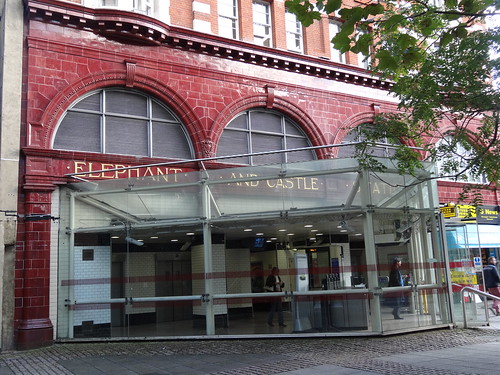
Elephant & Castle Bakerloo line exit – classic Leslie Green.
Impressions: Elephant & Castle is one of those parts of London that will never look good, no matter what scheme the council, developers or mayor’s office devise. The roundabout is designed only for cars and pedestrians are left as an afterthought.
Once you accept these facts, then the area isn’t so bad. Murals in the subways brighten up what would otherwise be very drab concrete walls. The Strata building is interesting and impressive.
And, the Bakerloo platforms are best accessed through a classic Leslie Green red brick entrance. Thus, if you’re a glass half-full kind of person there are some good points to the area that go at least partly mitigate the glaring negatives.
Random Fact: In 1924, the first recorded birth on the London Underground occurred at Elephant & Castle. There has been only 1 other since then. Tweet This
Tube Nerd Fact: The furthest south of Leslie Green’s Tube stations. Tweet This
Lambeth North
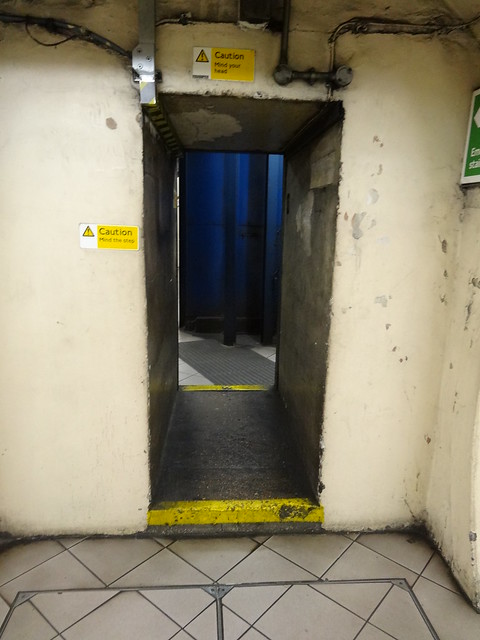
Narrow passageway to stairs at Lambeth North Station.
Impressions: The area immediately outside Lambeth North station is a marked improvement over Elephant & Castle, although I’d be worried if it wasn’t. However, the station itself seems to be in a bad way. Only one lift was working the day of my visit and the rest of the station looks incredibly worn and is certainly in need of an upgrade.
Random Fact: Lambeth North (originally called Kennington Road, then Westminster Bridge Road) was the original southern terminus of the Bakerloo line when it opened in 1906. Tweet This
Waterloo

Curved Bakerloo Line Platform at Waterloo
Impressions: Waterloo is the first station I have visited twice during this whole process. Having already written extensively about the area outside the station in my Waterloo & City line post, I won’t repeat myself here.
However, I uncovered two new aspects of Waterloo station during this visit: first, the route from the Bakerloo Line platforms to the main station is like a rabbit warren. Second, there are still a fair number of visible remnants of Waterloo International station, if you know where to look.
Random fact: From 1994 to 2007 Waterloo International station was the terminus of the Eurostar trains from France, meaning French tourists and business people had to disembark at a station named after the last major battle between Britain and France (which needless to say the French lost). Tweet This
Embankment
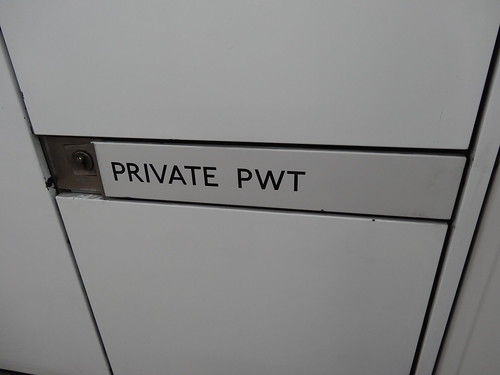
Mysterious Private PWT door at Embankment station
Impressions: My first impression of Embankment station is that it’s overrun with clueless tourists, but I knew that was going to be the case going in. The station also induces a small amount of claustrophobia as there doesn’t seem to be much space for all the people trying to use it.
Leaving by the Embankment exit gives you a good view and access to the Victoria embankment. Leave by the Villiers Street exit and you can jostle with tourists for a place to eat or drink.
Random Fact: Embankment station was original opened as Charing Cross due to its proximity to the rail station. Tweet This
Charing Cross
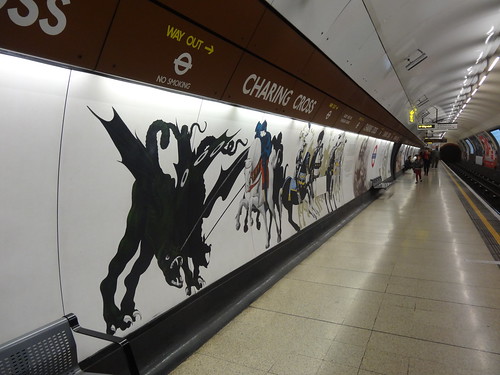
Bakerloo line platform at Charing Cross with art
Impressions: One of the most pointless Underground stations on the whole network. If you exit at Villiers Street you can actually see Embankment station at the other end. Given the distance you have to walk from the platform to street level, it seems likely to be more hassle than it’s worth to use.
At least the Bakerloo line platforms at Charing Cross have some interesting murals based on art you can see at the National Gallery and National Portrait Gallery.
Random Fact: The Tube scenes from Skyfall were shot on the disused Jubilee line platforms at Charing Cross. Tweet This
Piccadilly Circus
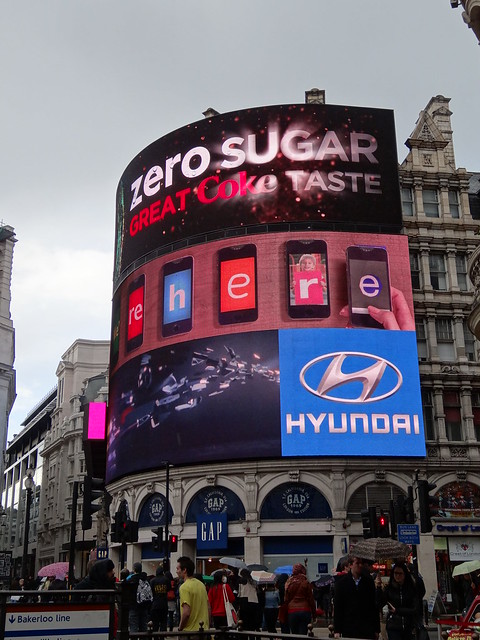
The heart of London? Piccadilly Circus Billboard with Bakerloo sign
Impressions: Piccadilly Circus is busy. This is London’s tourist ground zero. Just attempting to leave the station means running a gauntlet of mildly annoying tube behaviour: people standing on the left on the escalators, people waiting until they reach the ticket barrier to get their tickets or Oyster cards ready, people stopping immediately after they get through the ticket barrier, and large groups milling about the ticket hall are just some of things you can look forward to.
To top it all off, when I get to Piccadilly Circus it starts raining and the roof seems to have sprung a small leak. An improvised bucket solves the short term problem, but this is perhaps not the best impression to give to London’s visitors.
Random Fact: The wall separating the two Bakerloo line platforms abruptly ends if you go to the northern end of either. Tweet This
Oxford Circus

The worst of London summed up in a single photo.
Impressions: Still hate it. Worst place in London.
Random Fact: You can change trains across platforms between the Bakerloo and Victoria lines at Oxford Circus. Tweet This
Regent’s Park
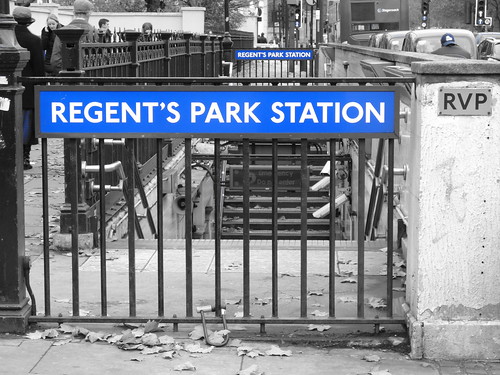
Looks like I found the blue filter – attempt at an artistic photo of Regent’s Park station
Impressions: Regent’s Park station is both lovely and quiet. With much of the original tiling still in place, the station retains the look and feel it would have had when it was opened over a century ago.
When you leave the station you’re faced with ugly Marylebone Road, but you can either head south to see the impressive houses of Park Crescent or, more likely, head north into Regent’s Park proper.
Random Fact: Regent’s Park station only received planning permission, after construction had begun on the rest of the Bakerloo Line. Tweet This
Baker Street
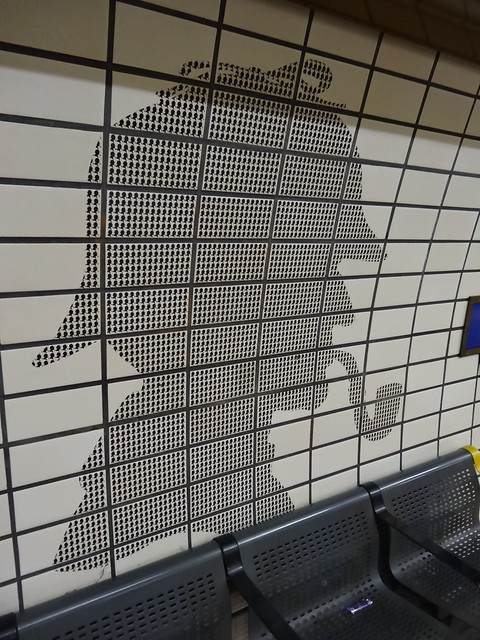
Cashing in on Baker Street’s most famous resident – Sherlock Holmes motif
Impressions: My initial impressions of Baker Street station aren’t really that positive. It’s busy with tourists who refuse to stand on the right. The Bakerloo platforms are entirely covered with Sherlock Holmes motifs, which feel overdone and tacky. It’s the closest station to Madame Tussaud’s, another one of London’s baffling and overpriced tourist attractions.
The only positive thing I can say about the station on this visit is that TFL’s Lost Property Office has a window display where you can see a small selection of what people have lost on the tube over the years (bowler hats, phones, cameras, etc.).
Tube Tip: If you lose something on the tube you should check the Lost Property office at Baker Street. Tweet This
Random Fact: The Bakerloo line platforms have Sherlock Holmes motifs, which are created from smaller Sherlock Holmes pictures. Tweet This
Marylebone

For the first 10 years of its life, Marylebone was known as Great Central
Impressions: Marylebone is a pleasant surprise. Unlike most other mainline rail stations, Marylebone has a human scale and quality to it. Thus, while not as impressive as St. Pancras, Paddington, or King’s Cross, I’d much rather catch a train here than at any of those other stations.
Having never visited Marylebone prior to this challenge, it’s my favourite central Bakerloo line station.
Random Fact: Marylebone Underground station was original called Great Central and you can still see the name on the tiles at platform level. Tweet This
Edgware Road
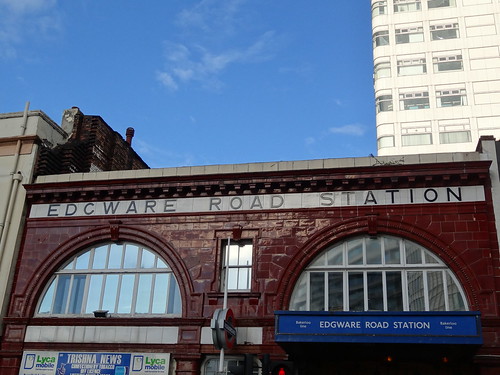
Part of the G seems to be missing from the tiled sign.
Impressions: While Edgware Road Station itself is nice enough inside, the area outside is not. Located on the rather busy Edgware Road and next to the Marylebone flyover, the first things I notice are concrete and cars. There’s a nice living wall around the side of the station, but this is not immediately obvious and does nothing to improve your first impression.
Random Fact: One of two stations to use the name Edgware Road. While close to each other, the two stations are not connected. Tweet This
Paddington

London Street runs next to Paddington
Impressions: Big and busy are the two words that best sum up Paddington for me. The railway station is notable for being designed by one of the greatest 19th century engineers, Isambard Kingdom Brunel (possibly one of the best named as well).
However, while the station itself is impressive, it is also the terminus for the Heathrow Express. This, coupled with the random fact below, makes navigating around the station particularly interesting.
Random Fact: Although the station is listed on TFL maps as a single station, there are actually two separate Paddington Underground stations. Tweet This
Warwick Avenue

The Warwick Avenue roundel – one of the few to include a destination.
Impressions: After Paddington and Edgware Road, Warwick Avenue station is a welcome relief. It is quiet and peaceful. As the roundel at the station will tell you, this station is for Little Venice. This marks the starting point (or ending point) for one of my favourite walks in London – the Regent’s Canal. The area is also notable for being rather well-to-do.
Random Fact: Warwick Avenue is one of only 3 stations with “for…” in the roundel, in this case ‘for Little Venice’. Tweet This
Maida Vale
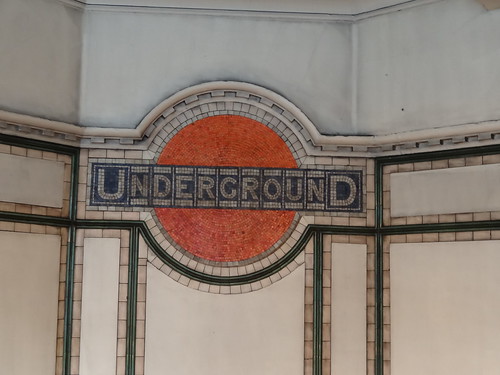
Mosaic Underground roundel at Maida Vale
Impressions: If possible, Maida Vale feels even more posh than Little Venice. Similar to Warwick Avenue, Maida Vale station is nice and quiet. It’s one of the Underground’s finer works, with the mosaics at the entrance being of particular note. The station is almost too perfect; more of what the tube could be rather than what it is.
Random Fact: Maida Vale was the first station to open with all-female staff. While the stationmaster was male, he also worked at two other stations. Tweet This
Kilburn Park

The uniquely wide Kilburn Park station.
Impressions: Kilburn Park station has a noticeably spacious feel to it compared to many of the previous stations on the line. However, the first thing you notice when leaving the station is that the area around it is noticeably rundown compared to Maida Vale and Little Venice.
One example of this is the Prince of Wales pub next to the station, which has managed to lose several letters from both its signs.
Random Fact: Kilburn Park is the last station located underground as you head north along the Bakerloo line. Tweet This
Queen’s Park

Rather dull top of Queen’s Park station
Impressions: Queen’s Park station doesn’t really leave much of a lasting impression. The area around here seems nicer than Kilburn Park, but there’s nothing obviously remarkable to be seen immediately outside the station.
Random Fact: The Overground and Bakerloo lines use the same tracks starting at Queen’s Park station. If going north, you can use either service. Tweet This
Kensal Green

The somewhat barn like Kensal Green station
Impressions: Kensal Green station is a nice, small station, with an entrance that looks more like a barn than anything else. The platforms are only partially covered, which means that if you’re at the wrong end of the train and it’s raining you’ll get wet. There’s not much to see immediately outside the station, but there doesn’t seem to be anything wrong with the area.
Random Fact: Kensal Rise station was originally called Kensal Green but was renamed in 1890. The current Kensal Green station opened 26 years later. Tweet This
Willesden Junction

Tracks into Willesden Junction
Impressions: Willesden Junction seems aptly named. It feels like a place you’d come to change trains, not leave them. Once you leave the main exit on Station Approach Road there is nothing to see. It really feels like you’re in the middle of an industrial wasteland. However, while the station building is nothing remarkable, it is modern and clean when I visit.
Random Fact: Willesden Junction opened in 1866 as part of the West Coast Main Line, but Bakerloo service wouldn’t begin until 1915 – 49 years later. Tweet This
Harlesden
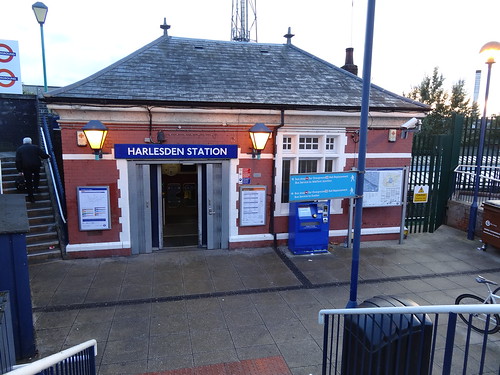
The child sized Harlesden station
Impressions: Harlesden is another area that’s difficult to get any strong feelings about. Still very industrial, but at least you can see the backs of some houses when you come out of the station. Yet, the whole area still feels rather nondescript. However, the station building itself can be best described as cute and tiny. More of a child’s size station than a real one.
Random Fact: The current Harlesden station dates from 1912, but an earlier station existed on the site from 1841 to 1866. Tweet This
Stonebridge Park
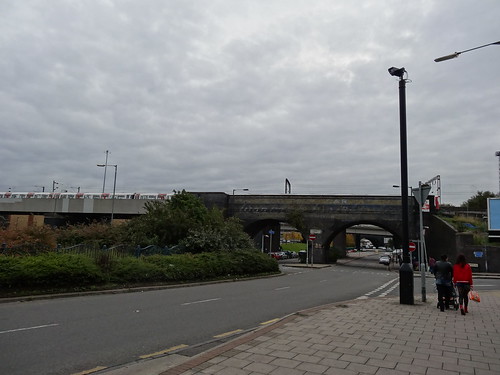
Tube approaching Stonebridge Park station
Impressions: Like Harlesden, Stonebridge Park station also has a very small station building. The area outside the station is not particularly attractive, as it is located next to the North Circular Road. The main reason to come to the station is to catch the free shuttle to Ikea Wembley.
Random Fact: The main Bakerloo line train depot is at Stonebridge Park. Tweet This
Wembley Central
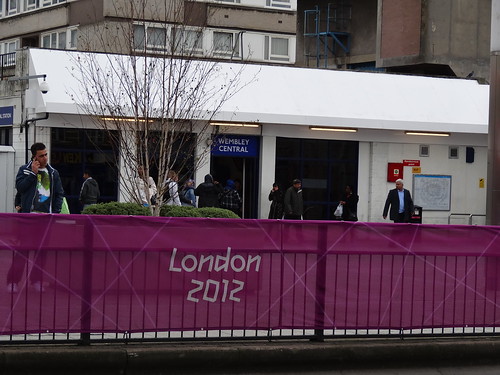
Busy Wembley Central with a leftover London 2012 sign.
Impressions: Between Stonebridge Park and Wembley Central you get some amazing views of Wembley Stadium, so I assumed it would be rather obvious where the stadium is when you leave the station – not so. Although well sign-posted, Wembley Stadium is about half a mile away.
Wembley Central station is rather Tardis-like; the inside of the station feels spacious while the entrance is relatively small, unobtrusive, and boring. A step down from the former Art Deco station entrance which was demolished to make way for the Wembley Central Square redevelopment.
Random Fact: Wembley Central got its current name in 1948 as result of the Olympic Games, which were hosted primarily at the Stadium. Tweet This
North Wembley

The much quieter North Wembley station
Impressions: By the time you get to North Wembley, you really feel as though you’ve left central London far behind. The area here has a real suburban feel to it. The station itself is a nice, small brick building – unremarkable but not unpleasant.
Random Fact: North Wembley station was originally going to be called East Lane. Tweet This
South Kenton

The odd, long pedestrian tunnel entrance to South Kenton station
Impressions: South Kenton is different from all other stations on the Bakerloo line. It also turned out to be my favourite. The current station dates from 1933 and the streamlined waiting room has an almost retro-futuristic feel to it.
Unlike other stations, access to the single island outdoor platforms is along a narrow pedestrian tunnel. There are no ticket barriers and the ticket office (when open) is at platform level.
You can also join the Capital Ring walk from here or visit the almost empty Northwick Park. Given the calm and quiet nature of the station, it feels miles away from Oxford Circus – not just physically but psychologically too.
Random Fact: South Kenton is the only station on the Bakerloo line that has no ticket barriers. Tweet This
Kenton

Kenton – the penultimate station – looks almost exactly like North Wembley
Impressions: Kenton station is rather odd in that it looks and feels exactly like North Wembley. Even the street outside the station has the same look and feel to it. If I hadn’t double checked the signs, I would have sworn I had taken the train in the wrong direction at South Kenton.
Random Fact: Walking between Kenton and Northwick Park stations is the fastest way to get between the Bakerloo and Metropolitan lines in North London. Tweet This
Harrow & Wealdstone
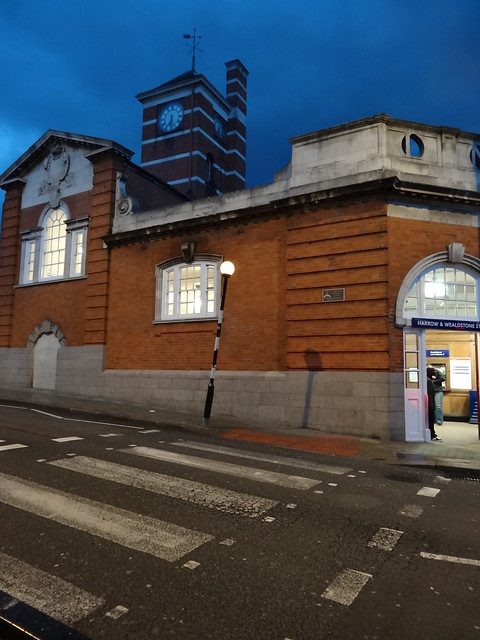
The main station building at Harrow & Wealdstone
Impressions: It feels more like a national rail station than a tube station. It also marks the end of another London Underground line. Located in zone 5, Harrow & Wealdstone is the furthest I’ve been from central London as part of this challenge.
It’s dark by the time I get here, and I’m looking forward to being done so I only take a quick look outside the station. However, based on this cursory glance it seems relatively nice, quiet, and suburban – certainly different from Elephant & Castle.
Random Fact: Harrow & Wealdstone was the site of a serious rail crash in 1952 that killed 112 people. Tweet This
Summary
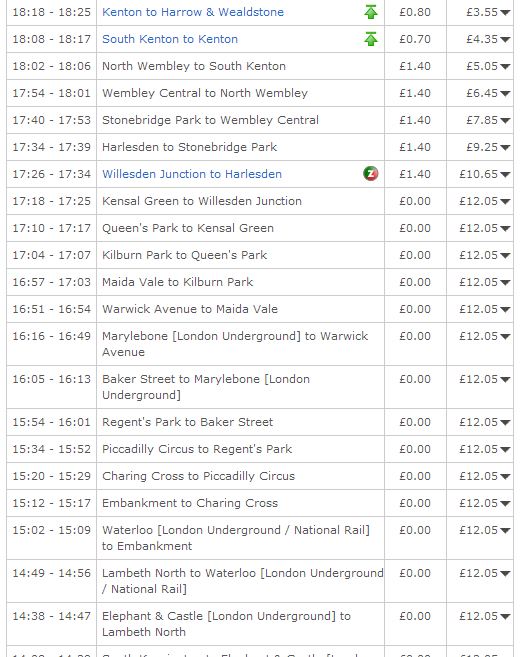
I’d be lying if I said the Bakerloo line was my favourite, or even among my favourite, London Underground lines. While it serves as a vital transit connection for many Londoners, I’m rather happy I don’t have to use on a regular basis.
The Bakerloo line links together many of my least favourite parts of London. The trains are also old but not vintage and feel dirty despite recent deep cleanings. Many of the stations are also in need of some cleaning and upgrades, especially Lambeth North.
However, despite these short-comings, there is still a lot to like about the line. There are some wonderful and unique stations to be seen (South Kenton, Marylebone, Maida Vale, etc.). Lower passenger volumes mean you are far more likely to get a seat.
And this is the first time during this challenge I’ve visited stations that aren’t underground. Considering that more than half the “Underground” is above ground, these are only the first of many.
10 Bakerloo Line Facts
- Number of stations: 25 (6 with no transfers). Tweet This
- Track length: 14.5 miles (23.2 km) (3rd shortest). Tweet This
- Opened: 1906; current layout from 1984. Tweet This
- Originally known as: Baker Street and Waterloo Railway, but changed its name a few months later to the now familiar Bakerloo line. Tweet This
- Origins: Line was supposedly built as a quicker way to get to Lord’s Cricket Ground. Tweet This
- Main Depot: Stonebridge Park Tweet This
- Random History Fact #1: Between 1917 and 1982, the line went as far north as Watford Junction. Tweet This
- Random History Fact #2: The Bakerloo line was the first Underground line to share track with main line railways when it extended service to Willesden Junction in 1915. Tweet This
- Random Fact #1: 9th busiest (3rd least used line) with 111 million passenger journeys per year. Tweet This.
- Random Fact #2: 4th most heavily used line in terms of passengers per mile. Tweet This
Favourite Station(s): South Kenton because of its unique design and feel. Marylebone and Maida Vale also deserve honourable mentions.
Least Favourite Station: For a second time in a row – Oxford Circus.
- Donate money to Bowel Cancer UK
- Subscribe to my RSS feed, follow me on Twitter, ‘like’ my Facebook page, or +1 my Google+ Page
- Write about the challenge on your own blog/website and/or link to this page. To contact me please send an e-mail wrightlondon [at] gmail.com
- Share this page on social media sites such as Twitter/Facebook/Google+, etc. (see buttons at the bottom of this page)
- Follow my current progress here.
- Buy me a pint or a night out (walking is thirsty business) – Just use the Paypal Buy Now Button below